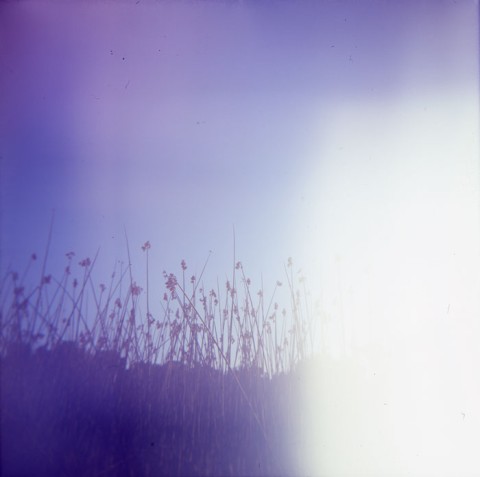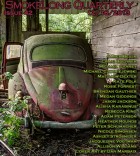In July, a new species of biting insect arrives in our city. We call them pinbugs. The pinbugs are tiny—each the size of a grain of sand—and they traverse plains of human skin in polite, single-file lines. Everywhere they go, the pinbugs bite, leaving a trail of dots on the host’s flesh. They take turns ducking out of line, nestling beside a single pore and depositing a batch of eggs into it. The eggs incubate for eleven hours and sixteen minutes. Then the invisible baby pinbugs hatch and feed on floating dust particles until they’re big enough to hop on the end of a line as it streams past.
The origin of the pinbugs is mysterious. The widely accepted theory is rapid evolution in the cargo hold of a flight from South America. A small, vocal contingent believes it’s a government conspiracy, in collusion with the bug spray industry. This doesn’t make sense, as the pinbugs are resistant to insecticides. People try anyway, slathering their bodies in DEET, wearing rain ponchos to bed so they don’t stain the sheets.
*
The pinbugs are adorable. Each day new electron microscope photos are released. Huge, shiny eyes; antennae that look like bashfully raised eyebrows; the upward curve of the lipless mouth suggesting a small, private smile. A cottage industry of pinbug stuffed animals, stickers, and t-shirts springs up. Children play Pinbug Tag at school, chasing each other in single file lines, squatting and covering their heads when it’s their turn to lay eggs.
*
Each pinbug bite feels like a hundred mosquito bites converging on one pin-sized spot of skin. When the bite is scratched, it dilates to the size of a dime. The itch burrows under the skin, to the bone. An echo of the itch can be felt on the other side of the affected limb or torso. Exit wounds. Some people cut their bites open, convinced there is something inside. The egg nests do not itch at all.
Drug dealers and other entrepreneurs empty drug store shelves of hydrocortisone creams and antihistamine pills, to be sold at outrageous markups. Desperate people walk down unfamiliar streets at all hours. They pay hundreds for thimble-sized vials, shoved through a slot in the bulletproof glass. These remedies dull the itch only slightly, and some people opt for illicit drugs, conveniently sold at the same location. Dissociative anesthetics like PCP and ketamine allow users to temporarily transcend the sensation of itching.
Others eschew drugs, seek alternative treatments. Pinbug Yoga studios pop up on every residential block. Each ninety-minute class comprises twenty minutes of meditation, sixty minutes of gentle stretching, and a final ten minutes of incantation, a slow, moaning plea to the pinbugs for mercy.
*
A tiny percentage of people, about one in every ten thousand, is allergic to pinbug secretions. No one has died yet, but neither has anyone revived from Pinbug Coma. Suddenly everyone has a friend, relative, or former neighbor in the Pinbug Ward, which requires visitors to undergo a comprehensive delousing procedure not unlike a trip to a spa. The procedure includes a complimentary lavender-scented cream that sells for fifty dollars an ounce on the black market.
*
We are an island of pinbugs, cut off from the world by an invisible magnetic net. City officials warn that touching the net with any part of the body will instantly render a person sterile. Throngs of people who don’t want children converge along the No Go Zone on Saturday nights. They drink sangria, smoke cigarettes dipped in PCP, and frolic in the magnetic veil.
The subway and railroad lines are shut down. No shipments are allowed in or out of our city. We are connoisseurs of canned and frozen food. In a grocery store downtown, two middle-aged women fistfight over the last can of their favorite baked beans.
The hospitals revise their policy regarding who may visit the Pinbug Comatose. Immediate family only. People were stealing the Hazmat suits.
*
A team of scientists goes on television to announce that they are close to a solution. Of course they mean killing the pinbugs. This enrages the Pinheads, a pinbug advocacy group whose members claim to experience spiritual ecstasy from the unrestrained scratching of their bites. The pleasure is intensified when the scratching is done by someone else. The Pinheads host Scratch Circles in members’ living rooms. The Scratch Circles are rumored to quickly devolve into old-fashioned orgies.
*
The pinbugs’ numbers are thinning, dispatched by a new species of carnivorous roach. We are relieved. The only catch is that we must allow the pinbug-eating roaches to swarm over us while we sleep. Fortunately, the roaches are small and fleet of foot. The squeamish seek respite in sedatives, the stronger the better. Nighttime burglaries and fire deaths have already risen eight percent.
*
Six months since the last report of a pinbug bite. The magnetic net is deactivated. The roaches are allowed to stream out of the city on the backs of pigeons, in coat pockets and trouser seams. Like the pinbugs, the roaches are resistant to conventional insecticides. Our scientists are developing a flavorless poison to be released into the water supply.
The roaches are hideous. They have long, barbed tusks. Their shells are filthy. They have no eyes.
Having devoured all the pinbugs, the roaches turn to alternative food sources. They eat dust mites from our pillows, dead skin cells pried artfully from our sleeping bodies.
We grow nostalgic for the eight months of Pinbug Quarantine. A one-act play called The Summer of Pinbugs enjoys wild popularity. Tattoo shops specialize in pieces that incorporate our long, looping chains of pinbug scars. We scratch our healed bites as if this might revive the sensation of itching. At night, children cling to their stuffed pinbugs and pray to fall asleep before the tusked roaches come out to feed.



 The core workshop of SmokeLong Fitness is all in writing, so you can take part from anywhere at anytime. We are excited about creating a supportive, consistent and structured environment for flash writers to work on their craft in a community. We are thrilled and proud to say that our workshop participants have won, placed, or been listed in every major flash competition. Community works.
The core workshop of SmokeLong Fitness is all in writing, so you can take part from anywhere at anytime. We are excited about creating a supportive, consistent and structured environment for flash writers to work on their craft in a community. We are thrilled and proud to say that our workshop participants have won, placed, or been listed in every major flash competition. Community works.